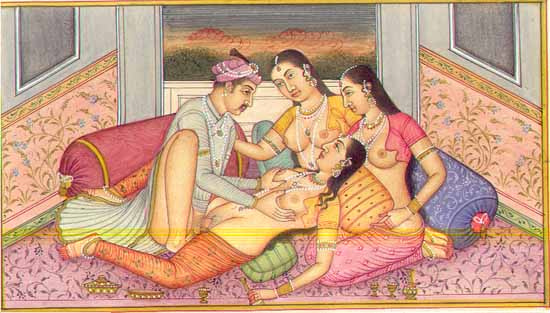I. Indian Subcontinent
A. Definition--a subcontinent can be defined as a large land mass isolated by geological features from the continent it is part of.
B. Geography of the Indian Subcontinent
1. Mountainous northern zone--the Himalayas and the Hindu Kush ranges to the north, which also includes heavily forested foothills and high meadows.
2. River Basins--northern India is drained by two large, silt-laden rivers: the Indus, which flows southwesterly, and the Ganges, which flows southeasterly.
3. Monsoon--the northern mountains shield India from cold Artic winds, and fives it a sub-tropical climate. This makes the land mass much warmer than the ocean that surrounds it, prompting the development of the monsoons.
a. Sailors in the Arabian Sea and the Indian Ocean quickly learned how to use the monsoon wind to their advantage.
C. The Vedic Age--historians call the period between 1500-500BCE the Vedic Age, after the Vedas people that serve as our main source of information about this period. Most historians believe that a new group of people, animal herding warriors who spoke an Indo-European language, emigrated to northwest India around 1500BCE, although some historians argue that this migration occurred much earlier.
1. Migration to the Ganges Plain--around 1000BCE, after the fall of the Indus civilization, some groups moved further east, along the banks of the Ganges River. They brought with them new iron tools, which allowed them to cut down trees and till the thick, fertile soil.
2. Varna--the invaders moved into the Indian subcontinent from central Asia were much lighter-skinned than the native people they were living amongst, the Dasa. Because these invaders, the Arya, were much more aggressive, they pushed many of the Dasa further south. The elites among the two groups intermarried to some extent, but the lower class were exclusively Dasa. The result was a mixture of different peoples of different skin hues, and with that grew an attempt by the lighter-skinned invaders to mark these differences in appearance into social differences.
a. Brahmins--priests and scholars
b. Kshatriya--warriors and royal officials
c. Vaishya--merchants, artisans, and landowners
d. Shudra--peasants and laborers
e. Dalit--or "untouchables," mainly native peoples who were relegated to those task seen as ritually "unclean"--butchering animals, leather working, removing waste
Members of each jati had very little contact with members of other castes; to do so ran the risk of becoming unclean, which necessitated purification rituals.
3. Karma--the class and caste system came to be connected to the widespread belief in reincarnation.
a. Reincarnation--the Brahmins taught that every living creature had an immortal essence, call atman (or breath). The atman became separated from the body at death, and then was later reborn in another body. Whether that body was human, animal, or insect depended upon the kind of life that had been led. People who led exemplary lives could then be reincarnated into a higher caste.
II. Imperial Expansion and Collapse, 324BCE-650CE
India has been characterized by political fragmentation for most of its history, largely due to its size, geographic barriers, language variation, and cultural practices
A. Mauryan Empire, 324-184BCE
1. Magadha Kingdom--located in eastern India south of the Ganges. The Magadha kingdom became increasingly wealthy by 600BCE, due to its location along overland trade routes, in addition to its wealth in agriculture and iron mines.
2. Chandragupta Maurya--may have been inspired by the example of Alexander the Great, who had recently invaded India as far east as the Punjab.
3. Chandragupta Maurya and his two successors managed to extend their control over much of the subcontinent, except for the southernmost tip.
4. The tax equivalent of about 25 percent of the yearly harvest supported the empire; this tax income was supplemented by excise taxes collected on trade goods passing through the empire. Income was also derived from the monopolization of alcohol sales, the manufacture of weapons, and fees charged for using irrigation systems that were built.
5. Reliance upon relatives to govern the far-flung empire
6. Ashoka--grandson of Chandragupta; at the beginning of his reign he engaged in military campaigns to extend his empire that resulted in thousands of people being killed. In a battle to conquer Kalinga, hundreds of thousands of people were killed, wounded, or deported. Overwhelmed by the brutality, the young king became a convert to Buddhism.
B. Commerce and Culture in an Era of Political Fragmentation
1. Fall of the Mauryan Empire--although the empire prospered for several years after Ashoka's death in 232BCE, dynastic disputes, the cost of maintaining a huge army, and the administrative costs in running the empire all contributed to its fall.
2. Politic unrest outside the borders of the empire contributed to its downfall, as well; eventually several of the foreign powers exercised some political control over the region.
3. Cities established during the Mauryan era continued to carry on a lively trade, and India remained an important cog in the trade that occurred between China, Southeast Asia, Central Asia, the Middle East, Eastern Africa, and the Mediterranean. This trade fostered the use of coins, for which a value was easier to establish
4. Guilds--with the decrease in central authority, guilds of merchants and artisans became politically powerful in the cities and town
5. Epic poetry--both the Ramayana and the Mahabharata, based upon oral traditions going back hundreds of years, achieved their written forms during this era.
6. The Tamil Kingdoms--the southern tip of the subcontinent remained in the control of the Tamil peoples. Although three of the Kingdoms--the Cholas, the Pandyas, and the Cheras-- were in near-constant conflict with one another, and each experienced periods of ascendancy and decline, this was the also the era of the flowering of Tamil culture.
C. The Gupta Empire, 320-550CE
1. Chandra Gupta--consciously modeled himself on Chandragupta Maurya, and led his kingdom from its capital Pataliputra on the Ganges Plain. The Gupta Empire was never as large as the Mauryan Empire, but Gupta power extended across northern and central India, west to Punjab and east to Bengal, north to Kashmir, and south into the Deccan Plateau.
2. Trade routes--like the Mauryan predecessor, the Guptas enjoyed the same strategic advantages, sitting astride the same trade routes, exploiting the same agricultural productivity of the Ganges Plain, and controlling iron deposits..
3. Administrative bureaucracy--less onerous than the Mauryan. The administrative bureaucracy was smaller and less intensive, as was its spy network. The standing army relied on marksmanship with bow and arrow and skill on horseback (learned from their nomadic conquerors), rather than superior numbers. This allowed the Gupta's to closely control the core of the empire, while relying on governors paying tribute to control the periphery.
4. The "Theater State"--without a large standing army to keep underlings and vassals in line, the Gupta relied instead on pomp and circumstance--solemn ceremonies, rituals, and cultural events that advertised the benefits of association with the empire. And gifts. Lost of gifts.
5. The role of women--during the Gupta era, women lost rights, and males increased their control of the lives of the women in their families.
a. Kama Sutra--sold in bookstores today an kind of an exotic sex manual, it was more a directory to the proper way men and women should behave with one another in Indian society.
b. Great emphasis on the "purity" of women, ensuring women were "maidens" (virgins) before they were married. This eventually led to women becoming betrothed at extremely young ages--some as early as six or seven years of age--to ensure their virginity.
c. Sati--the ritual where wives who outlived their husbands were expected to cremate themselves on their husbands' funeral pyre; women who failed to do this were ostracized, cut off from their families, and disinherited.
d. Women of higher social status could sometimes escape this fate, as could women who joined religious communities.
6. Rise of Hinduism--the Gupta's were Hindu (whereas the Maruyan's had been Buddhist) and revived ancient Vedic practices that gave their ceremonies an aura of sanctity. They incorporated Brahmin priests into these ceremonies and validated the role of the priests--who in turn used their influence to validate the Gupta's rule ) and were rewarded with substantial land grants, etc.).
7. Fall of the Gupta--pressure from Hun raids on the Gupta northern frontier, and the expense of attempting to defend it, exhausted the Gupta treasury, and led to the downfall of the empire.











Hi,
ReplyDeleteJust to let you know that Kshatriya's are the caste above Brahmins. Brahmins use to work under Kshatriya's and use to give advice to them. So the picture signifying Brahmins above Kshatriya's is incorrect.
Harrah's Resort Southern California - MapYRO
ReplyDeleteFind all 창원 출장샵 Harrah's 포항 출장마사지 Resort Southern California, Stateline, CA, 영천 출장마사지 United States of 강원도 출장마사지 America, ratings, photos, prices, 경상남도 출장마사지 expert advice, traveler reviews and tips,